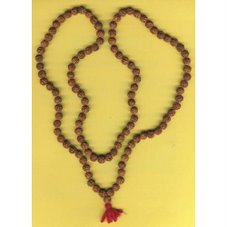The only way to keep up with the latest about rudraksha is to constantly stay on the lookout for new information. If you read everything you find about rudraksha, it won't take long for you to become an influential authority.
Rudraksha trees have large evergreen broad leaves which grows in the area from the Gangetic Plain to the foothills of Himalayas. Rudraksha trees are also found in middle areas of Nepal. Rudraksha seeds are covered by an outer shell of blue color when fully ripe, therefore, Rudraksha seeds are also called as blueberry beads. It is also used for treatment of various diseases in Indian traditional medicine.
Rudraksha in Sanskrit literally means "the eye of Rudra" or "red-eyed", from rud, "to cry," and aksha, meaning "eye". In one story by Śaivites, God himself (Śiva) shed a tear, on viewing the misfortunes of humanity. This single tear became the first Rudraksha tree, and a sign of his compassion. In another story, while destroying the asura fortress of Tripura (mythology), the seeds from Lord Siva's eyes emerged to form rudraksha. Rudraksha literally stands for the eyes of Lord Shiva implying that it was "pleasant to the eyes of Lord" (Shiva), and hence it is named in his honour. Traditionally it is considered sacred and are said to have diverse mystical powers, including being an amulet against evil forces.
Rudraraka beads are the material from which sacred garlands (108 beads in number) or rosaries are made. In essence, rudraksha is a Saivite rosary. They are used for japa mala. Rudraraka is a common aid to worship in Śaivism. Rudraksha mala are worn by Hindu monks, and many devotees wear a single bead hung from their neck. The use of rudraraksha can distinguish denomination amongst Hindus. Vaishnavites use beads made of tulsi while Saivites use rudraraksa. In Tantric Buddhism rudraksha beads are sometimes used for the practice of wrathful deities.
Rudraksha has special qualities to identify the type of food. In ancient Indian culture, yogis divided the food into 3 categories - Positive Pranic, Negative Pranic and Neutral/Zero Pranic. When the Rudraksha mala is being held above the foods, it'll rotate clocwise for positive pranic, anticlockwise for negative Pranic and pendulum action for zero pranic foods. A person can use this as a test to identify true Rudraksh (If the person holds it over plain water it will rotate clockwise and if they add one drop of some chemical used to clean the floor, it will change to rotate in anticlockwise)
Truthfully, the only difference between you and rudraksha experts is time. If you'll invest a little more time in reading, you'll be that much nearer to expert status when it comes to rudraksha.
There are many different varieties of Rudraksh available in the world divided based on the grooves in the mukhi Rudraksh like Pachamukha (5 faces), Gowri shankar (2 face), Eka mukha (1 face) etc. Each one has its own individual capabilities when it is being worn by any person. Rudraksh has the capabilities of holding the energy of the person who is wearing it, unlike Spadika (which has only cooling effect on the body) or anything other. There is a myth that this one should not be worn by people who are consuming non-vegetarian, couples and women during mensus periods - but they are not true. Anyone can wear it any time.
The Rudraksh seeds are brittle in nature and so it should be avoided from chemical and toileteries Wearing Rudraksha mala cleanses a person's aura.
Origin & Myths Rudraksha has its etymological origin in the Sanskrit words, ‘Rudra’ and ‘Aksha’. ‘Rudra’ is another name for Lord Shiva, and ‘aksha’ means teardrop. Mythological tales have it that the Rudraksha plant was born out of Lord Shiva’s tear drops. Ancient scriptures, such as ‘Shiva Purana’, ‘Padma Purana’ and ‘Srimad Bhagavad’ mention the greatness and wonderful powers of the Rudraksha. For thousands of years, they have adorned the bodies of sages and saints leading a fearless life in far-flung frontiers seeking enlightenment and liberation.
According to the Ayurvedic medical system, medicinal value and biomedical properties of wearing Rudraksha are positive effect on the heart and nerves, relieve from stress, anxiety, depression, palpitations and wavering thoutht or lack of concentration. It is also known for its anti-ageing effect, electromagnetic and inductive properties. The use of Rudraksha seeds in people with high blood pressure have been found have beneficial effect.
It never hurts to be well-informed with the latest on rudraksha. Compare what you've learned here to future articles so that you can stay alert to changes in the area of rudraksha.
Subscribe to:
Post Comments (Atom)


1 comment:
The word Rudraksha literally means the tears of Lord Shiva. In the physical form, rudraksha is the seed of the Elaecarpus ganitrus tree, which is commonly used for making Rudraksha Malas or Rosaries.
Visit: http://www.divine-rudraksha.com/
Post a Comment